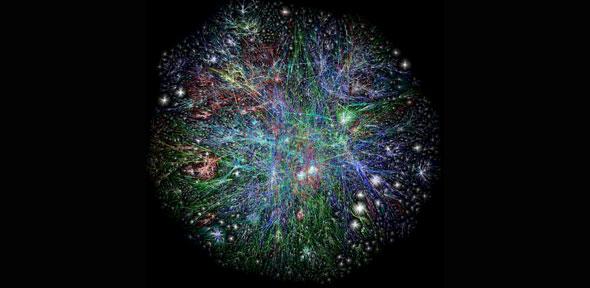
A revolutionary new architecture aims to make the internet more “social” by eliminating the need to connect to servers and enabling all content to be shared more efficiently.
One colleague asked me how, using this architecture, you would get to the server. The answer is: you don’t.
Dirk Trossen
Researchers have taken the first step towards a radical new architecture for the internet, which they claim will transform the way in which information is shared online, and make it faster and safer to use.
The prototype, which has been developed as part of an EU-funded project called “Pursuit”, is being put forward as a proof-of concept model for overhauling the existing structure of the internet’s IP layer, through which isolated networks are connected, or “internetworked”.
The Pursuit Internet would, according to its creators, enable a more socially-minded and intelligent system, in which users would be able to obtain information without needing direct access to the servers where content is initially stored.
Instead, individual computers would be able to copy and republish content on receipt, providing other users with the option to access data, or fragments of data, from a wide range of locations rather than the source itself. Essentially, the model would enable all online content to be shared in a manner emulating the “peer-to-peer” approach taken by some file-sharing sites, but on an unprecedented, internet-wide scale.
That would potentially make the internet faster, more efficient, and more capable of withstanding rapidly escalating levels of global user demand. It would also make information delivery almost immune to server crashes, and significantly enhance the ability of users to control access to their private information online.
While this would lead to an even wider dispersal of online materials than we experience now, however, the researchers behind the project also argue that by focusing on information rather than the web addresses (URLs) where it is stored, digital content would become more secure. They envisage that by making individual bits of data recognisable, that data could be “fingerprinted” to show that it comes from an authorised source.
Dr Dirk Trossen, a senior researcher at the University of Cambridge Computer Lab, and the technical manager for Pursuit, said: “The current internet architecture is based on the idea that one computer calls another, with packets of information moving between them, from end to end. As users, however, we aren’t interested in the storage location or connecting the endpoints. What we want is the stuff that lives there.”
“Our system focuses on the way in which society itself uses the internet to get hold of that content. It puts information first. One colleague asked me how, using this architecture, you would get to the server. The answer is: you don’t. The only reason we care about web addresses and servers now is because the people who designed the network tell us that we need to. What we are really after is content and information.”
Go deeper with Bing News on:
Pursuit Internet
- Nebraska State Patrol arrests two people following pursuit in Omaha
The Nebraska State Patrol arrested two people early Saturday after a pursuit that ended in a southwest Omaha home’s attic. About 11:55 p.m. Friday, a State Patrol trooper attempted a traffic ...
- Indiana man killed during pursuit had history of resisting police
As officers approached the suspect, he fled and during a foot pursuit an exchange of gunfire occurred, police said. The man, later identified as Mura, was wounded in the shootout and taken to a ...
- Pursuit leads to crash in SE Oklahoma City
OKLAHOMA CITY (KFOR) – A pursuit led to a crash in southeast Oklahoma City Friday morning. Officials say the accident happened around 1:30 a.m. near SE 18th St. and Byers Ave. During the chase ...
- SUV overturns at end of violent pursuit crash in Los Angeles
An SUV driven by a burglary suspect was left upside down following a wild chase that ended in the Central-Alameda neighborhood of Los Angeles Wednesday morning. Annie Rose Ramos reports for the KTLA 5 ...
- Stolen vehicle pursuit in Southern California ends in violent rollover crash
A stolen vehicle suspect who led authorities in Southern California in a high-speed pursuit before it ended in a violent rollover crash was arrested Tuesday in West Covina. Officers with the La ...
Go deeper with Google Headlines on:
Pursuit Internet
[google_news title=”” keyword=”Pursuit Internet” num_posts=”5″ blurb_length=”0″ show_thumb=”left”]
Go deeper with Bing News on:
Radical new architecture for the internet
- Radical new cancer vaccine could be a game-changer for melanoma patients
The hospitals are being asked to save an unrealistic amount of money, there is a shortage of GP's and a third of NZDF's navy ships aren't being used due to staffing shortages. A revolutionary new ...
- A radical new book sets out to hunt for 'pure consciousness'
Books about consciousness don’t come any more radical (or with a longer title ... We'll also keep you up to date with New Scientist events and special offers.
- The origins of our digital dystopia
Underneath the TikTok story (and the Meta story, and all the anxiety-provoking platforms that worry policymakers) is a throughline that runs straight back to the dawn of the internet, and the American ...
- Is the Internet the Enemy of Progress?
But it’s 29 years old, written when the true internet era was still just a gleam in Al Gore’s eye. And as prophecies go, it’s pretty impressive — up there with Malcolm’s rather more famous prediction ...
- The headphones that could ease tinnitus with a radical new treatment
Headphones that swap sounds from one ear to the other could be a radical new treatment for tinnitus — the ringing noise in the ears that affects around five million people in the UK. When a ...
Go deeper with Google Headlines on:
Radical new architecture for the internet
[google_news title=”” keyword=”radical new architecture for the internet” num_posts=”5″ blurb_length=”0″ show_thumb=”left”]











